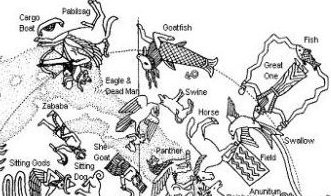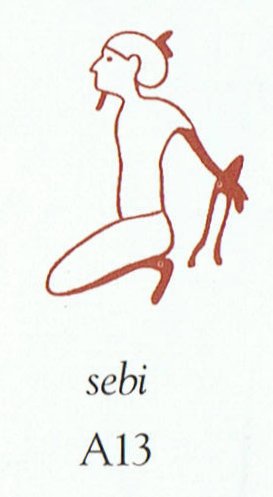Once again. The Milky Way (the Nile) was there for transporting the souls of the dead to their rebirths in spring. This vehicle was female in character. ... There is a couple residing in one place named Kui and Fakataka. After the couple stay together for a while Fakataka is pregnant. So they go away because they wish to go to another place - they go. The canoe goes and goes, the wind roars, the sea churns, the canoe sinks. Kui expires while Fakataka swims. Fakataka swims and swims, reaching another land. She goes there and stays on the upraised reef in the freshwater pools on the reef, and there delivers her child, a boy child ... Fakataka = Haka-taka means 'to create a circle'.
The Milky Way leads up from the Sagittarius Archer with the Eagle flying above and carrying the soul of the Dead Man in his claws:
... The figure of the Dead Man is drawn like they used to picture prisoners in ancient Egypt, with arms bound at the back, here as described in Wilkinson:
A13 refers to Sir Alan Gardiner's well-known Sign List, according to which a prisoner very well could be regarded as an adversary (traitor) of the Pharaoh:
Bound hands should be on the back side, I think, because a pair of hands can represent the 10 months of Sun. By being on the back side they are pacified, changed from an active to the passive state ... ... The Eagle is highly alive and not a Falling Eagle. The flight takes the 'prisoner' up, following the Milky Way. Hamlet's Mill has cryptic comments which surely must be considered: There is also a Finnish folktale which repeats the well-known Babylonian story of Etana and the Eagle.² ² See M. Haavio, Der Etanamythos in Finnland (1995), pp. 8-12; also S. Langdon, The Legend of Etana and the Eagle (1932), pp. 46-50. Here, instead of the King, it is the 'Son of the Widow' (no reason is given for this epithet, which appears to belong to Perceval in the first line, but we find it again in later Masonic tradition)³ who is taken up into the air by a griffin and sees the earth growing smaller and smaller under him. ³ Such words have long lives. At the height of Pickett's Charge at Gettysburg, the first man over the wall was Gen. Armistead, who fell into the breach mortally wounded. To those who picked him up, the general kept repeating: 'I am a Son of the Widow' - obviously the password of a secret military brotherhood that his captors did not understand, nor the historian eíther. When the earth appears 'no bigger than a pea' (analogous similes are to be found also in Etana), the griffin plunges straightaway to the bottom of the sea, where the hero finds a certain object for which he had looked everywhere, and finally he is restored to land. This looks like the full story of what in the Babylonian cuneiform is interrupted halfway through because the tablet is broken off: it might be the first version of the legend of Alexander exploring the Three Realms. The text immediately previous was as follows (cfr at The Little Bald Woman): ... Youkahainen tries to overcome the ancient sage by asking cosmological riddles, but Vainamoinen 'sings' the Lapp step by step into the bog up to his throat, and sings his magic formulae 'backwards' to free him only when the Lapp has promised him Aino, his only sister. There was also the tale of Vainamoinen searching in the dead giant's belly for three lost runes. These, unless they are treated as 'just so stories', look very much like 'erratic boulders' deposited in Finland by the glacial movement of time. For once, it is possible to trace the archaic formation back to Egypt. A young Egyptian called Setna (or Seton Chamwese) wanted to steal the magic book of Thot from the corpse of Nefer-ka Ptah, one of the great Egyptian gods, who was often portrayed as a mummy. Ptah, however, was awake and asked him: 'Are you able to take this book away with the help of a knowing scribe, or do you want to overcome me at checkerboards? Will you play Fifty-Two?' Setna agreed, and the board with its 'dogs' (pieces) being brought up, Nefer-ka Ptah won a game, spoke a formula, laid the checkerboard upon Setna's head and made him sink into the ground up to his hips. On the third time, he made him sink up to his ears, then Setna cried aloud for his brother, who saved him ... According to Wilkinson - commenting on A13 in his Hieroglyfernas värld (Reading Egyptian Art) - small bound figures were sometimes used as pieces in the senet (and similar) board games.
Well now; as to my earler comment quoted above regarding how both hands should be bound on the back side in order to represent 10 months (fingers), it should be added that Hercules was bound to an oak by a '5-fold bond', ... The manner of his death can be reconstructed from a variety of legends, folk-customs and other religious survivals. At mid-summer, at the end of a half-year reign, Hercules is made drunk with mead and led into the middle of a circle of twelve stones arranged around an oak, in front of which stands an altar-stone; the oak has been lopped until it is T-shaped. He is bound to it with willow thongs in the 'five-fold bond' which joins wrists, neck, and ankles together ... because this resembles the rebirth of the same members later: ... There is a couple residing in one place named Kui and Fakataka. After the couple stay together for a while Fakataka is pregnant. So they go away because they wish to go to another place - they go. The canoe goes and goes, the wind roars, the sea churns, the canoe sinks. Kui expires while Fakataka swims. Fakataka swims and swims, reaching another land. She goes there and stays on the upraised reef in the freshwater pools on the reef, and there delivers her child, a boy child. She gives him the name Taetagaloa. When the baby is born a golden plover flies over and alights upon the reef. (Kua fanau lā te pepe kae lele mai te tuli oi tū mai i te papa). And so the woman thus names various parts of the child beginning with the name 'the plover' (tuli): neck (tuliulu), elbow (tulilima), knee (tulivae) ...
Anciently the Sun would have reached the Nile (Milky Way) not in January 5 (370) - i.e. in day 107 (= 214 / 2) counted from the beginning of the C text - but 60 days earlier than in °December 31. I.e. in NOVEMBER 1 (*225) = *285 - 60:
... the modern Homo occidentalis is bound to shrink back from the mere idea that the Nile represented a circle, where 'source' and 'mouth' meet, so that there is nothing preposterous in the notion that a Canopic mouth can be found in the geographical North ...
|
|||||||||||||||||||||||||||||||||||||||||||||||||||||||||||||||||||||||||||||||||||||||||||||||||||||||||||||||||||||||













